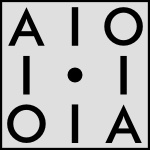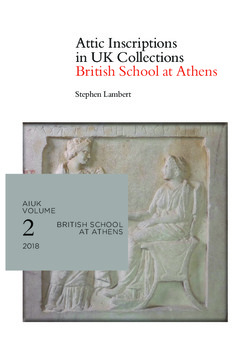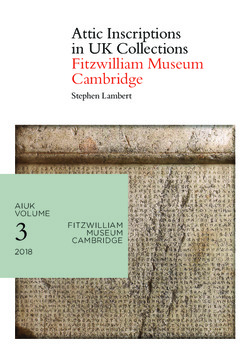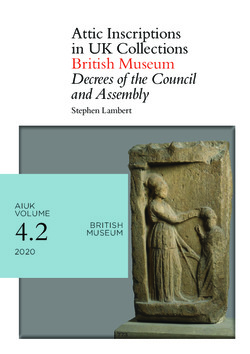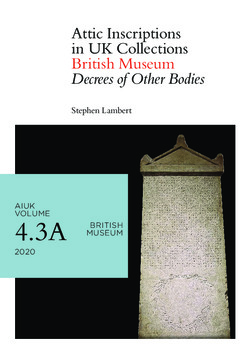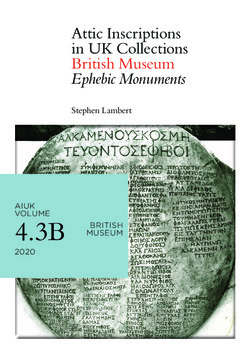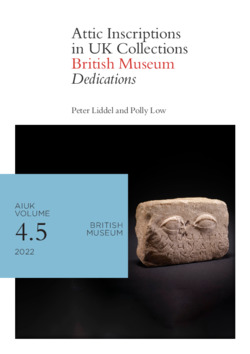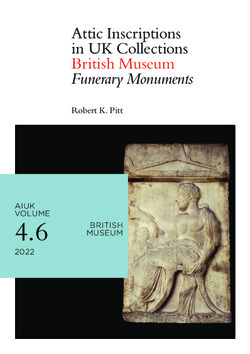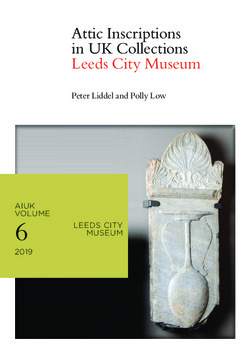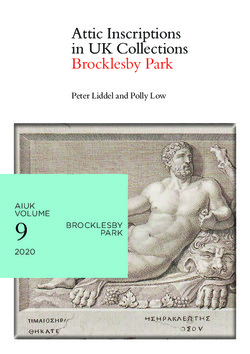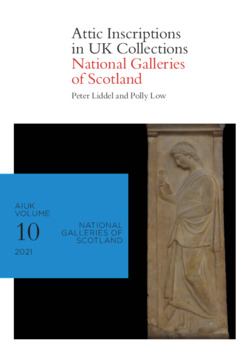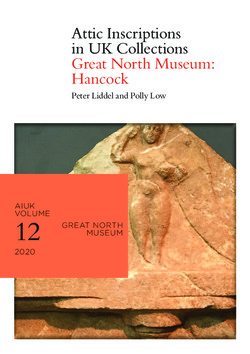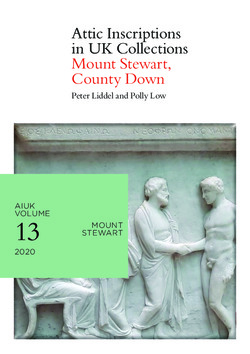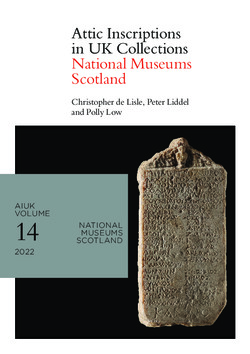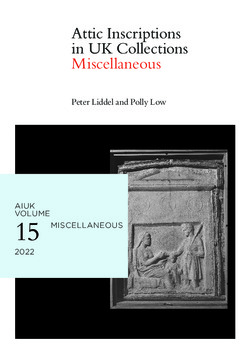AIUK Papers
AIUK 1
AIUK vol. 1 (2018): Petworth House - Stephen Lambert
This, the inaugural volume of AIUK, publishes the important hellenistic inscription in Petworth House. Dating to 108/7 BC it honours the maidens who worked on the robe (peplos) for the statue of Athena. Another small fragment of the same inscription is in the Epigraphical Museum, Athens. It is one of three similar inscriptions which date to around the same decade and seem to reflect a revival or reform of the arrangements for making the peplos, which was carried in procession and presented to the goddess at the Panathenaia festival. The names of the maidens are listed in a “roll of honour” at the bottom of the inscription. This and the lists of maidens in the other two inscriptions supply us with much of our information on the female members of elite Athenian families at this period.
View paperAIUK 2
AIUK vol. 2 (2018): British School at Athens - Stephen Lambert
This second volume of AIUK contains the fifteen Attic inscriptions in the collection of the British School at Athens, most of which once belonged to the nineteenth-century philhellene, historian of modern Greece and resident of Athens, George Finlay. Though modest in size, the collection offers a rich variety of insights into the life of our best documented ancient Greek city between the fifth century BC and the third century AD. It also offers representative examples of three major genres of Attic inscription: two Assembly decrees (1, 2); five dedications or statue bases (3, 4, 5, 6, 7); and seven funerary monuments (9, 10, 11, 12, 13, 14, 15); in addition to a list of names, perhaps of donors, on a wall block (8). Three of the Attic funerary monuments, 9, 10 and 14, are on permanent display in the BSA entrance hall, and the remaining inscriptions are kept in the School’s museum collection.
View paperAIUK 3
AIUK vol. 3 (2018): Fitzwilliam Museum, Cambridge - Stephen Lambert
This, the third volume of AIUK, publishes new editions of the nine Attic inscriptions in the Fitzwilliam Museum, Cambridge, seven of which are on display in the Museum’s Greek and Roman galleries. In addition to two Assembly decrees (1, 2), the collection contains the “Sandwich marble”, an important set of accounts of the sanctuary of Apollo on Delos (3). It also includes six inscribed Attic funerary monuments (4-9), and the discussions of the individual monuments are preceded by a general introduction to the major styles of private Attic funerary monument represented in the collection. The volume contains a number of new readings and fresh observations on most of the inscriptions discussed.
View paperAIUK 4.1
AIUK vol. 4.1 (2019): British Museum. Cult Provisions - Stephen Lambert
AIUK 4.1 is the first part of our publication of the Attic inscriptions in the British Museum, which is designed to supersede E. L. Hicks ed., Ancient Greek Inscriptions in the British Museum. Part I (Attika) (1874), as supplemented by the Attic material included in F. H. Marshall ed. Part IV. Section II (1916). This part contains new editions of three inscriptions of the 5th century BC which make cult provisions, a boustrophedon altar from the City Eleusinion, a sacrificial calendar, and the ordinances of the deme Skambonidai. In addition to updating the editions in the light of the progress of scholarship since 1874, including new fragments, we improve the current published texts of the inscriptions and make original contributions to their interpretation. We also discuss the history of their acquisition by the Museum in the 18th and 19th centuries, and the roles played by Richard Chandler, the Society of Dilettanti and Lord Elgin.
View paperAIUK 4.2
AIUK vol. 4.2 (2020): British Museum. Decrees of the Council and Assembly - Stephen Lambert
This, the second part of our publication of the Attic inscriptions in the British Museum, contains new editions of the seventeen decrees of the Council and Assembly in the collection. All were acquired in Athens by UK aristocrats in the early 19th century and are published here in most cases together with other fragments of the same inscriptions still in Athens. The inscriptions offer a series of illuminating snapshots of the policy preoccupations of Athenian citizens across the entire span of Athenian decree-inscribing, from the early 5th century BC to the early 3rd century AD, and include important documents of the Eleusinian Mysteries and the Athenian Empire as well as characteristic inscriptions of the 4th century BC and Hellenistic and Roman Athens. Introductory sections discuss the history of the collection and locate the inscriptions in the context of Athenian decree-inscribing and Athenian history more broadly. In addition to significant new epigraphical findings this edition includes reassessments of several major inscriptions.
View paperAIUK 4.3A
AIUK vol. 4.3A (2020): British Museum. Decrees of Other Bodies - Stephen Lambert
This, Part 3A of our publication of the Attic inscriptions in the British Museum, contains new editions of the ten decrees of “Other Bodies” in the collection, i.e. bodies other than the Council and Assembly. They include three of the five known decrees of the deme Piraeus, all of which were acquired in Athens by Richard Chandler in 1765-6 and donated to the Museum by the Society of Dilettanti in 1785; three enactments of Hellenistic voluntary associations; a Hellenistic decree of the Athenian community of Myrina on Lemnos; a fragmentary inscribed letter to Hadrian or Antoninus Pius; the beginning of a decree of the world-wide itinerant association of theatrical professionals dating to the reign of Antoninus Pius; and one of the very few known inscribed decrees of the Areopagos, dating to 195/6 AD.
View paperAIUK 4.3B
AIUK vol. 4.3B (2020): British Museum. Ephebic Monuments - Stephen Lambert
This, Part 3B of our publication of the Attic Inscriptions in the British Museum, contains the five inscriptions in the collection which are or may be from monuments containing catalogues of young men who participated in the ephebate, the training programme that is one of the most richly documented institutions of Hellenistic and Roman Athens. Four of the five date to the Roman period; the fifth is earlier, but may not in fact be an ephebic catalogue. Four of the inscriptions were collected by early-19th century aristocrats (Lord Elgin and Viscount Strangford), but the most substantial item, a striking monument in the shape of a shield, was acquired in Athens by the mid-18th-century physician and collector, Anthony Askew.
View paperAIUK 4.5
AIUK vol. 4.5 (2022): British Museum. Dedications - Peter Liddel and Polly Low
In this instalment of our publication of the Attic inscriptions in the British Museum we present new editions of the Museum's collection of twenty-seven Athenian dedications: inscriptions typically recording offerings made to a deity, either in the hope of or as thanks for some act of divine favour or assistance, but including also statue bases and herms. We also edit one dedication which has conventionally been included in the Attic corpora but which, in our view, does not derive from Attica. The inscriptions date from the fourth century BC to the Roman imperial period; they include dedications made in private and public contexts, by men and women from all strata of Athenian society; and they offer examples of a wide range of physical forms, from simple plaques to elaborate sculpted reliefs. Taken as a whole, they give a very good insight into both the persistence and the diversity of this aspect of the Athenian epigraphic habit. We also discuss the history of this part of the Museum's collection: many of these inscriptions were collected by Lord Elgin, but some were acquired by other (mostly) aristocratic travellers and collectors, and some arrived in London via more circuitous routes.
View paperAIUK 4.6
AIUK vol. 4.6 (2022): British Museum. Funerary Monuments - Robert K. Pitt
This, Part 6 of our publication of the Attic inscriptions in the British Museum, presents new editions of the eighty inscribed Athenian funerary monuments in the Museum, along with three further inscriptions which have at times been thought Athenian, but which are probably not. They are mainly private monuments, some inscribed merely with names, others with more or less lengthy verse epigrams. Some are undecorated, others adorned with relief sculpture (or paintings), often figurative and representing the deceased alone, or more often in family groups. The collection also includes three public monuments of the fifth century BC recording casualties in battle. These monuments afford us a fascinating insight into funerary and commemorative practices from the sixth century BC to the fifth century AD, as well as casting light on Athenian society, its values and beliefs, more generally. The volume also explores the collection history of these marbles, most of which were obtained from Greece in the eighteenth and nineteenth centuries, and which is full of individual stories of intrepid travellers, dubiously conducted excavations, sponsored expeditions, crates of antiquities shipped and captured at sea, as well as chance discoveries of ancient stones in a London builder’s yard and an Essex garden rockery, their own travel narratives unfortunately lost en route.
View paperAIUK 5
AIUK vol. 5 (2019): Lyme Park - Peter Liddel and Polly Low
AIUK 5 publishes new editions of the two Attic inscriptions at Lyme Park, Cheshire, both of them funerary monuments with relief sculpture dating from the fourth century BC. In addition to analysis of the monuments in their ancient context, the volume explores the engaging history of their acquisition in Athens in 1811 or 1812 by Thomas Legh and their display as part of his design for the Library of Lyme Park. AIUK 5 also discusses briefly the intriguing uninscribed piece of fourth-century Athenian sculpture depicting a seated man with comic masks, which is displayed in the same room.
View paperAIUK 6
AIUK vol. 6 (2019): Leeds City Museum - Peter Liddel and Polly Low
AIUK 6 publishes a new edition of the inscribed fourth-century Attic funerary monument with relief in the collection of the Leeds City Museum and narrates the sequence of events by which it and a number of other antiquities were acquired by two young Yorkshiremen visiting Greece on the “Grand Tour” in 1817, and were eventually donated to the Museum of the Leeds Philosophical and Literary Society in 1863. An Appendix discusses another inscribed funerary monument in the collection, currently identified as Attic in most standard epigraphical reference works, but actually from the island of Rheneia by Delos.
View paperAIUK 7
AIUK vol. 7 (2019): Chatsworth - Peter Liddel and Polly Low
AIUK 7 publishes the two Attic inscriptions currently located at Chatsworth in Derbyshire, the seat of the Dukes of Devonshire; also included in this paper is a third inscription which was known to be at Chatsworth in the twentieth century but is now lost. This is a diverse collection: there is one funerary lekythos, dating to the fourth century BC; a statue base of the second or third century AD, set up at Eleusis in honour of the Roman Empress Julia Domna; and a fragment of a public document, probably (we argue) a decree of the Athenian Assembly. We also discuss the history of the collection of antiquities at Chatsworth, and explore the various routes by which these inscriptions might have reached Derbyshire.
View paperAIUK 8
AIUK vol. 8 (2019): Broomhall - Peter Liddel and Polly Low
It is well-known that the majority of the “Elgin marbles” were transferred from the possession of the 7th Earl of Elgin to the British Museum in 1816 by an Act of Parliament. However, a relatively small number of antiquities remain in the ownership of the Elgin family. AIUK 8 publishes the five Attic inscriptions currently held in the collection of the 11th Earl of Elgin at Broomhall in Scotland (Fife). They were acquired by the 7th Earl probably during the second decade of the nineteenth century. All five are funerary monuments: 1 is a spectacular example of a painted classical funerary monument; 2 and 3 are excellent examples of classical funerary stelai. 4 is a funerary monument for an adherent of the Isis cult in Athens. 5 is a rare example of an Athenian sarcophagus bearing an inscription. In this publication we offer new readings and interpretations of these monuments, which illustrate different ways that funerary monuments might be re-used in antiquity.
View paperAIUK 9
AIUK vol. 9 (2020): Brocklesby Park - Peter Liddel and Polly Low
Brocklesby Park in Lincolnshire is home to the collection of antiquities amassed in the late eighteenth century by Sir Richard Worsley (and originally kept and displayed in his house at Appuldurcombe, Isle of Wight). AIUK 9 publishes the four Attic inscriptions which are now part of the collection: two funerary monuments, and two dedications. We propose a new interpretation of one of these dedications (which has previously been interpreted as a funerary monument), and argue that it formed part of a monument, other fragments of which have been discovered in the excavations of the Athenian Agora, commemorating victory in the anthippasia. We publish also a fifth inscription, another dedication, which was part of Worsley’s original collection but whose location is now unknown. The volume includes a detailed discussion of the history of the collection, which was one of the earliest assemblages of Greek antiquities in the United Kingdom and remains one of the most significant privately-held collections in the country.
View paperAIUK 10
AIUK vol. 10 (2021): National Galleries of Scotland - Peter Liddel and Polly Low
AIUK 10 publishes a new edition of the two inscribed Attic funerary stelai currently held in the collections of the National Galleries of Scotland, Edinburgh. One is a tall stele of the fourth century BC representing a young woman; the other is a pedimental stele depicting two female figures shaking hands (in dexiosis): we suggest that the latter is a fourth-century original re-used in the second century AD. Both monuments derive from the collection of the Dowager Lady Ruthven of Winton Castle, which she bequeathed to the National Gallery of Scotland in her will of 1884. We offer a detailed reassessment of the stelai and a full account of their collection history.
View paperAIUK 11
AIUK vol. 11 (2020): Ashmolean Museum Oxford - Christopher de Lisle
AIUK 11 provides new editions of the sixteen Attic inscriptions in the Ashmolean Museum, Oxford. The collection was largely formed by travellers to Greece in the 17th and 18th centuries (William Petty, George Wheler, and James Dawkins) and it forms a significant chapter in the history of early modern British engagement with Greek epigraphy and material culture. The inscriptions include a proxeny decree from the early 4th century BC (1), a Roman-period calendar of offerings (2), and an honorific altar of the 4th century AD, which is one of the last attestations of the Eleusinian Mysteries (3). There are also seven inscriptions relating to the ephebate in the Roman Imperial period (4-10), as well as six inscribed funerary monuments ranging in date from the early fourth century BC to the early third century AD (11-16). An appendix presents one of the earliest examples of a Greek epigraphic forgery, dating to the late 17th century.
View paperAIUK 12
AIUK vol. 12 (2020): Great North Museum: Hancock - Peter Liddel and Polly Low
AIUK 12 presents the first edition of a fourth-century Attic funerary monument in the collection of the Great North Museum: Hancock in the city of Newcastle upon Tyne. The iconography of this monument offers tantalising insights into the life and most likely premature death of Pantakles, the person named in the inscription. The stele was added to the Greek collection of the museum in 1980; we discuss the role of Professor Brian Shefton (1919-2012) in its purchase and the development of a public collection which has contributed greatly to the accessibility of Greek antiquities to the general public in the north-east of England.
View paperAIUK 13
AIUK vol. 13 (2020): Mount Stewart, County Down - Peter Liddel and Polly Low
AIUK 13 publishes the only Athenian inscription known to be currently located in Northern Ireland: it is held at the Mount Stewart estate (County Down), home of the Stewart family since the 1740s. An intriguing funerary monument of the fourth century BC, it depicts two pairs of individuals engaged in separate acts of dexiosis, with a fifth person represented in the background. We tentatively raise the possibility that it belonged to a wealthy family associated with the guardianship of the orator Demosthenes and his property. We discuss the possible function of the monument in terms of projecting claims about status. Little is known about the stone’s history before the early twentieth century; accordingly, we explore the different routes through which the inscription might have come into the possession of the Stewart family.
View paperAIUK 14
AIUK vol. 14 (2022): National Museums Scotland - Christopher de Lisle, Peter Liddel and Polly Low
AIUK 14 presents the first edition of a list of 31 friends who had completed the year of military training and civic education, the ephebate, in Athens in the first century AD. The inscription was donated to the Society of Antiquaries of Scotland in 1887-8 by A. W. Inglis and has been in Edinburgh in the collection of National Museums Scotland, since 1954. It dates to the same year in the reign of Claudius as another list of ephebic friends in the Ashmolean Museum and among its interesting features are frequent use of hypocoristic names (short forms, used familiarly) and two Greek personal names that were previously unknown. The list also casts light on the inclusion in the ephebate at this period of young men who were not Athenian citizens. As well as onomastic analysis, our edition of the inscription locates it in its social and historical context, with the help of Chris de Lisle's recent edition of the Ashmolean inscription, AIUK 11 no. 5, and of his general study of the ephebate in Roman Athens, AIO Papers 12.
View paperAIUK 15
AIUK vol. 15 (2022): Miscellaneous - Peter Liddel and Polly Low
The primary purpose of this AIUK volume is to offer an account of those UK collections which once held Attic inscriptions, but which have now been dispersed (as a result of sale or donation to other UK or overseas collections), or whose present whereabouts is unknown. The volume is intended to complement and supplement other volumes in the AIUK series, and also earlier guides to ancient Greek antiquities in UK collections. It discusses fifteen collections in the United Kingdom which are recorded as having contained Attic inscriptions, or which hold inscriptions whose Attic provenance is uncertain. It includes full editions of two possibly Attic inscriptions at Bignor Park, West Sussex. In addition, we discuss inscriptions held in two collections in the Republic of Ireland. The volume includes addenda and corrigenda to earlier AIUK volumes (other than the British Museum volumes); most important among these is an addition to AIUK 11 (Ashmolean Museum, Oxford), the funerary stele of Epiktesis.
View paper